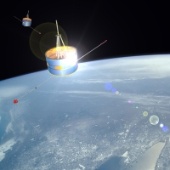ESA Science & Technology - News Archive
News archive
News archive
Published: 7 June 2005
Images taken with the Wide Field Planetary Camera 2 on board Hubble were combined to create a detailed view of the supernova remnant N 63A, located in the Large Magellanic Cloud, showing the impact on the ambient gas clouds.
Published: 7 June 2005
In a recent article in Nature, Giovanni Bignami (chairman SSAC) gives a vision for the future of ESA and its role in the context of a new Europe.
Published: 3 June 2005
A destinctive bright feature is observed on the surface of Titan. It is apparent both at visual and infrared wavelengths in observations made by Cassini during flybys of Saturn's largest moon.
Published: 27 May 2005
Among INTEGRAL's science goals is the study of objects residing at the centre of our galaxy, and the physical processes at play in this region.
Published: 25 May 2005
On 10 May 2005, the ESA Science Programme Committee approved the extension of the Double Star mission for a period of 17 months, pushing back the end date from July 2005 to December 2006.
Published: 12 May 2005
Published: 12 May 2005
Published: 11 May 2005
Published: 11 May 2005
An update on ESA's Cosmic Vision 2015-2025 was presented to the Science Programme Committee showing current status, envisaged programme structure and timeline for potential implementation.
Published: 10 May 2005
Published: 28 April 2005
New results from simulations based on Cluster data are providing insight in the processes that transfer solar wind plasma into the Earth's magnetotail when the Interplanetary Magnetic Field is strongly northward oriented.
Published: 28 April 2005
Published: 25 April 2005
To celebrate the 15th anniversary of the Hubble Space Telescope, two of the most detailed pictures ever taken with the ACS camera were revealed today.
Published: 25 April 2005
Phase variation in the X-ray emissions from three pulsars has been examined using the EPIC instrument on XMM-Newton. In a paper published this week in the Astrophysical Journal scientists reveal that analysis of spectra over the pulsar rotation period has enabled them to track hot spots on the surface of the neutron star.
Published: 22 April 2005
Based on observations by the ESA/NASA SOHO mission a Chinese-German team of scientists have identified the magnetic structures in the solar corona where the fast solar wind originates.
Published: 22 April 2005
Published: 21 April 2005
The 39th ESLAB Symposium opened with a summary, by Giovanni Bignami (Chairman of ESA Space Science Advisory Committee), on the current status of the Cosmic Vision 2015-2025 long-term plan.
Published: 20 April 2005
Imaging of the Moon's polar regions by the AMIE camera onboard SMART-1 is helping in the search for points on the Moon's surface where the Sun never sets.
Published: 14 April 2005
—
20 Items per Page













